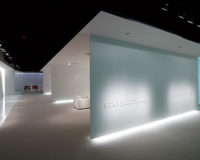A new design district is rapidly emerging just north of Madison Square Park in New York, with retail outlets and showrooms for such upscale commercial and residential brands as Porcelanosa, Sicis, and Duravit. One of the neighborhood’s latest arrivals is the New York flagship for both Bernhardt Design and Bernhardt Textiles. The contract furnishings company’s recently completed 20,000-square-foot showroom created by Rottet Studio with lighting by One Lux Studio features an understated interior design and a gentle illumination that, according to firm principal Lauren Rottet, “clears your head from visual clutter.”
Sensory detox begins at the threshold of the pristine showroom, which occupies the third floor of a Beaux Arts skyscraper on Madison Avenue. In the elevator lobby, the glow of 3000K-hued LEDs emanates from a suspended ceiling while glass- or light-edged walls—backlit with the corporate logos of the two divisions—appear to float on either side of the entrance. To the left of these walls, a narrow window into the showroom offers a glimpse of its so-called “runway”: a gallery of furnishings and textiles along east- and south-facing windows with a ceiling that reaches the original structure’s 14-foot height. “Every line manipulates where your eye is supposed to go,” Rottet says of the peekaboo window, though, as she notes, showroom design cannot distract from the items for sale.
To support the architect’s minimalist philosophy, lighting draws visitors in and around the showroom, even if many of the light sources are hidden. “We wanted the light to appear like a natural phenomenon, not a layering of hardware,” explains One Luxe founding partner Stephen Margulies. For example, as downlights in the lowered ceiling provide an even, ambient glow in the reception area, crisp beams from discreet LED strips tucked into coves frame its varied planes. These strokes of light amplify a canted wall directly facing the elevator lobby that frames a bright red Mellow sofa by Océane Delain that won an ICFF Editors’ Award last year. Shining around a Calacatta marble-clad wall and desk adjacent to the entry, the hidden LEDs make the monumental stone seem almost weightless. Throughout the vestibule and reception areas, a snowy terrazzo floor of crushed Turkish porcelain reflects the light to emphasize the ethereal quality of the space.
Bernhardt staffers say customers are welcome to spend the entire day in this clean, intriguing atmosphere, but Rottet’s scheme keeps them moving through it. By reaching toward the daylit “runway,” the suspended ceiling guides visitors beyond reception. This knife-edge canopy skirts the length of the soaring L-shaped gallery, to serve as a wayfinding device between the displays here and additional furniture vignettes positioned entirely beneath it near the building core. The beveled canopy terminates above a solid surface bar area at the end of the runway, anchored by a 15-by-11½-foot backlit wall made of a similar material, both of which feature marbleized patterning.
The showroom maintains the 3000K color temperature throughout its passages and display areas to optimize visitors’ perception of color. Sheer white draperies at the windows are downlit to help mitigate the room’s mediocre views and varying weather conditions, explains Margulies. The soft lighting on the gauzy fabric also turns rows of windows into a more neutral backdrop for the furniture.
Sounding a pragmatic note, the lighting designer adds, “Bernhardt recognizes that you have to have many light sources, or otherwise the furniture goes dead.” Within the runway, then, LED downlights in the canopy and rows of track luminaires mounted to the original ceiling spotlight products along the route. Internal galleries that sit fully underneath the canopy of the lower ceiling height are largely devoted to showing case goods for office applications, and feature abundant track lighting. All are easily reconfigurable to serve a rotation of setups. “We were really concerned about having enough light to hit the merchandise, no matter the location,” Margulies says, observing that, given the amount of equipment needed to guarantee coverage, affordable track pads bearing LED lamps perform comparably to other, more expensive track-lighting products.
As much as their various strategies provide escape from the visual stimulation of Manhattan, the collaborators agree that, ultimately, the design of the showroom celebrates the client’s brand. Bernhardt Design products eschew spectacle and trends, so their new home is deliberately quiet. Besides deferring to the merchandise, says Rottet, who has designed furniture for the North Carolina–based manufacturer, architectural understatement echoes her client’s approach to its craft. “Just as an angle here or there makes a huge difference in how you perceive an interior, the way a piece of leather is piped or seamed is a marker of its quality.”
CreditsArchitect: Rottet Studio — Lauren Rottet, principal; David Davis, Josef Jelinek, James Cull, Ashley Liu, Kefan Lu, Laurence Cartledge, Harout Dedeyan, project team
One Lux Studio — Stephen Margulies, Founding Principal; Yon Choy – Senior Associate; Kate Park – Designer
The Office of James Ruderman (structural); Jack Green & Associates
|
SpecificationsLighting: Contech (track); USAI, Gotham (downlights); EcoSense (cove); Jake Dyson Lighting (task)
Sherwin-Williams (paint); Formica (plastic laminate); Artistic Tile (marble); Krion (solid surface)
Amadeus Marble & Granite (terrazzo); Armstrong (resilient); Mohawk (carpet)
Windowtex
CR Laurence |










